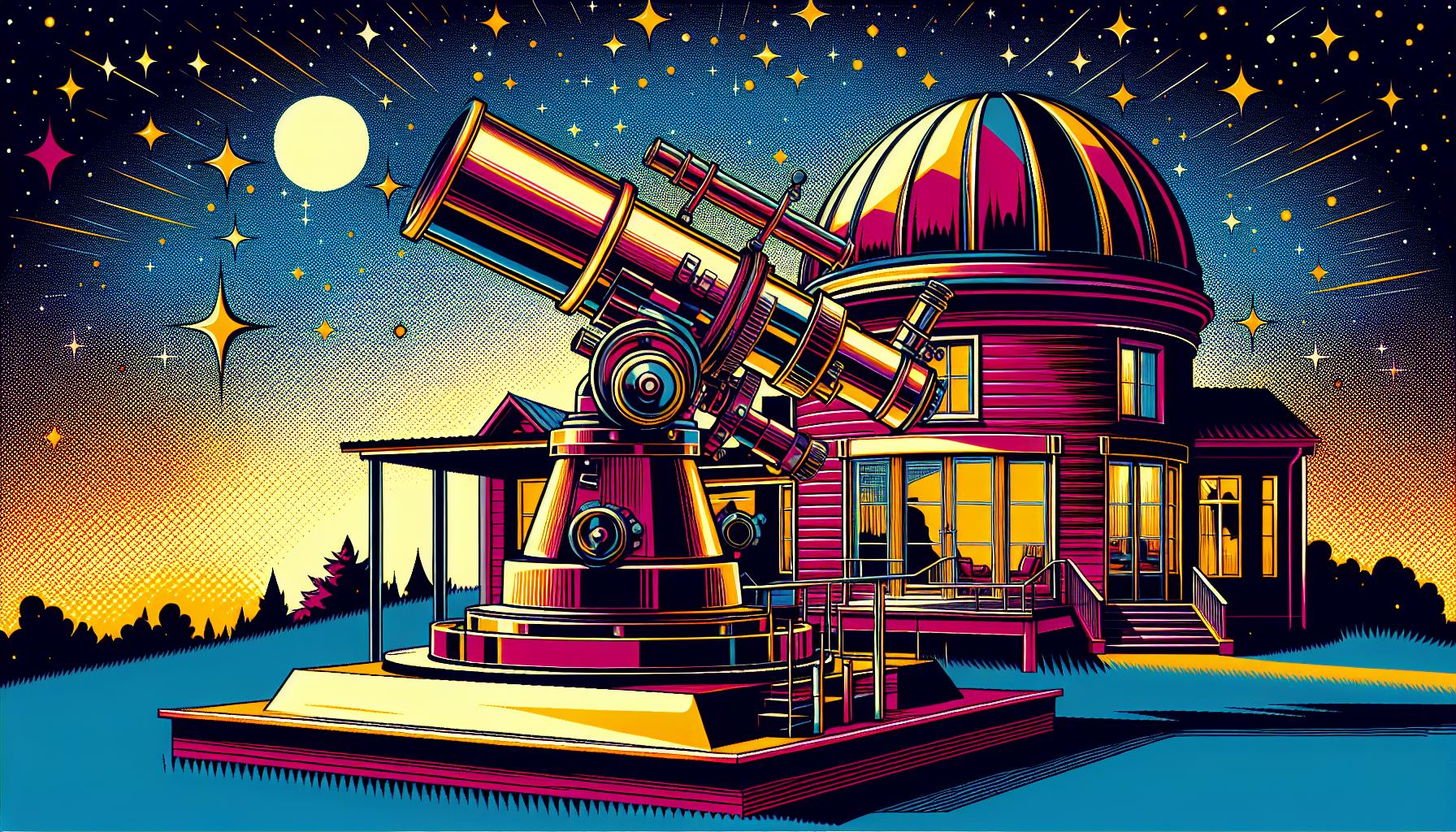This site contains affiliate links to products. I may receive a commission for purchases made through these links.
Stargazing from your backyard is a fantastic experience, but it’s even better when you’ve got your own home observatory. If you’re like me, the idea of having a personal space to explore the cosmos is incredibly exciting. But one question that often comes up is, “how much does a home observatory cost?”
Understanding the components of a home observatory
Before we delve into the costs, it’s crucial to understand what exactly goes into a home observatory. It’s not just about a telescope on the rooftop. A well-functioning home observatory comprises of various key components:
Telescopes and Mounts
The main star of the show is, of course, the telescope. They come in a wide variety of types and sizes, each with its unique features and costs. The telescope isn’t a standalone item though; it’s typically mounted on a sturdy stand, called the mount. The mount can be either alt-azimuth or equatorial, depending on how it’s aligned with the Earth’s axis. The type of mount you choose will depend on your stargazing objectives.
Observatory Dome or Roof
A significant part of the home observatory setup is the observatory dome or roof. This is designed to provide a protective shelter for your equipment and optimize viewing conditions by blocking out light pollution. Prefabricated domes are available on the market, but you can also opt for a DIY job if you’re handy with tools.
Other Essential Equipment
The home observatory setup can be as simple or elaborate as you want. Additional pieces of equipment might include:
- Computerized controls
- Comfortable seating
- Heating elements for cold nights
- Specialized stargazing equipment like star charts, binoculars, and additional scopes
As I mentioned, the cost of these components can vary greatly based on the features you choose. But one thing’s for sure – a home observatory adds a whole new dimension to the term “home improvement”! Let’s now explore the broad cost range of building a home observatory.
Factors that influence the cost of a home observatory
One might wonder why the price of establishing a home observatory varies so widely. The cost’s inconsistency primarily results from the significant differences in the quality, size, and type of equipment one decides to install.
Firstly, telescopes may account for a considerable part of the budget. Less advanced and smaller models can cost as low as $200, while top professional telescopes can run into the tens of thousands. So, my advice would be to consider what type of celestial bodies you’d like to monitor. If you’re just starting, you might be better off slanting towards a less expensive model and upgrade as your passion and knowledge grow.
Secondly, the other equipment, such as the mount for the telescope, also impacts the cost. You may start with a simple mount for less than $100. However, more advanced mounts that provide features like automated tracking can cost several thousands of dollars.
Another crucial part of a home observatory that determines the cost is the housing structure, which comprises the dome or roof. Simple shed-like structures might be inexpensive, primarily if you build them yourselves. However, more sophisticated, motorized domes can propel the price way higher.
Other factors could also impact the cost. These include:
- Location: Where is your home located? Urban spaces might require light-pollution filters, while rural fields may pose challenges with transporting the equipment.
- Maintenance: Routine upkeep of the observatory can also incur costs over time.
- Insurance: Don’t forget to factor in the cost of insuring your valuable equipment.
Here’s a simplified cost overview for a home observatory set-up:
| Equipment | Cost range |
|---|---|
| Telescope | $200 to $10,000+ |
| Mount | $100 to $5,000+ |
| Observatory Dome/Roof | $500 to $10,000+ |
| Maintenance and Insurance | Varies |
As you’re embarking on your star-gazing journey, remember, creating a home observatory is as much a passion project as it is a valuable home improvement endeavor. So, focus on what matters to you the most, whether it’s exploring the night sky’s depths or finding peace in the quiet of the universe around us. After all, we are all star-stuff, contemplating the stars.
Budget-friendly options for a home observatory
Being passionate about astronomy, you might be interested in setting up your very own home observatory. It’s crucial to know that you don’t always need to break the bank to enjoy night sky gazing. Let’s explore some budget-friendly options.
First and foremost, choice of telescope significantly impacts the cost. For beginners, a decent quality refractor or Dobsonian telescope is a good start. These can be obtained for a few hundred dollars or less. Ordinarily, high-end telescopes with advanced functions cost thousands of dollars. Keeping it simple however, doesn’t necessarily mean compromising on quality.
An often overlooked, yet less expensive investment, your telescope’s mount needs careful consideration. While motor-driven mounts bring superior precision compared to manual, they come at a higher cost. Opt for a manual mount if you’re just starting out, then upgrade as needed.
Onto the observatory structure, or ‘housing’. Simple structures such as a shed or a canopy can play the efficient role of a basic observatory. These economic choices can be handy especially in places where the weather changes often. A flexible tent or portable dome could also be an option, as compared to a fixed structure.
The costs and types of equipment for a budget setup can be represented as:
| Equipment | Type | Cost |
|---|---|---|
| Telescope | Refractor/Dobsonian | <$200 |
| Mount | Manual | <$100 |
| Housing | Shed/Canopy | <$500 |
Complementary tech can also be sourced economically. Secondhand or refurbished equipment isn’t a bad starting point.
Mid-range options for a home observatory
Having discussed the budget-friendly options, let’s explore the mid-range choices. These options blend elements of affordability with features that are often attractive to the dedicated hobbyist.
The mid-range telescope market presents a variety of models available, priced roughly around $500-$2000. For this price, a motorized mount becomes an attainable feature. This is useful, as it can automatically track celestial objects across the sky. Some smart scopes in this range offer Wi-Fi control and databases of astronomical objects to view. These are fascinating features that can make your stargazing experience more enjoyable and educative.
If you’re looking at structures, an inflatable or pop-up observatory is another option in the mid-range bracket. They provide a much better shielding against light pollution and the elements than a canopy or shed. These typically cost between $300 and $700.
Bringing electricity to power your setup is another consideration. Solar power kits are available in this mid-range bracket that can manage your electricity needs for the observatory. These cost in the ballpark of $500.
Here’s a quick snapshot of these costs.
| Component | Expected Cost |
|---|---|
| Telescope | $500-$2000 |
| Observatory | $300-$700 |
| Power Kit | Around $500 |
It’s essential to recognize that these are just estimates. Prices can vary based on brand, location, new versus used, and ongoing sales or discounts. But nonetheless, investing in these mid-range options does provide a more immersive and automated stargazing experience.
High-end options for a home observatory
Swinging towards the higher end of the spectrum, we find options that are as exhilarating as they are costly. Here, enthusiast-grade equipment combines superior optical quality with advanced features to immerse us in the celestial world like never before.
High-end home observatory telescopes are not merely light-gathering devices, they are impressively engineered machines that bring the cosmos directly to our backyards. The price range for these advanced scopes is wide – starting from $2000 and skyrocketing to over $20,000. In return for the premium price tag, these high-flying scopes offer advanced motorized mounts, superior optics, highly detailed databases, and even sophisticated software for mapping out celestial bodies with stunning accuracy.
In terms of observatory structures, domed or rotating observatories represent the cream of the crop. They provide optimal protection against elements and light pollution, allow for precise tracking of astronomical bodies, and most importantly, validate the serious enthusiast’s commitment to sky-gazing. These advanced structures cost between $2,000 to over $10,000, depending on the size and features.
In comparison to the mid-range segment, a high-end setup requires a more substantial solar power system. These systems aren’t just about powering telescopes; they also power computers, motorized roofs, lighting, and heating appliances. Accordingly, these systems can cost between $1000-$4000.
Here’s a simplified summary table:
| Mid-range ($) | High-end ($) | |
|---|---|---|
| Telescopes | 500-2000 | 2000-20,000+ |
| Observatory structures | 300-700 | 2000-10,000+ |
| Solar power systems | 500 | 1000-4000 |
Without a doubt, high-end observatories require a significant financial commitment. However, the elevated investment opens up a universe of deeper exploration, increased clarity, and an exceedingly immersive experience.
Conclusion
So, if you’re asking how much a home observatory costs, it’s clear there’s no one-size-fits-all answer. It largely depends on the level of sophistication you’re aiming for. If you’re after a high-end setup, you’re looking at a significant investment. You could spend anywhere from $2000 to over $20,000 on a telescope alone. Add in a domed or rotating observatory structure, and that’s another $2,000 to $10,000. Don’t forget the solar power system, which will set you back between $1000 and $4000.
But remember, these costs buy you superior optical quality, advanced features, and an immersive stargazing experience. It’s an investment in a deeper exploration of the universe from the comfort of your own home.
FAQ
What features do high-end telescopes offer?
High-end telescopes offer superior optical quality and advanced features like motorized mounts, detailed databases, and sophisticated software to ensure a deeper exploration and an immersive experience.
What types of structures are best for high-end home observatories?
Domed or rotating observatories are considered the best structures for high-end home observatories. These structures offer the highest level of protection and precise tracking of celestial bodies.
How much do high-end telescopes cost?
High-end telescopes can range from $2,000 to over $20,000. The increase in cost corresponds to the quality and complexity of features offered.
How much does a high-end home observatory structure cost?
The cost of a high-end home observatory structure such as a domed or rotating observatory can range from $2,000 to over $10,000.
Why does a high-end setup require a substantial solar power system?
A high-end setup requires a substantial solar power system because of the energy requirements of the advanced features and motorized parts. The cost of such a system can range from $1,000 to $4,000.



